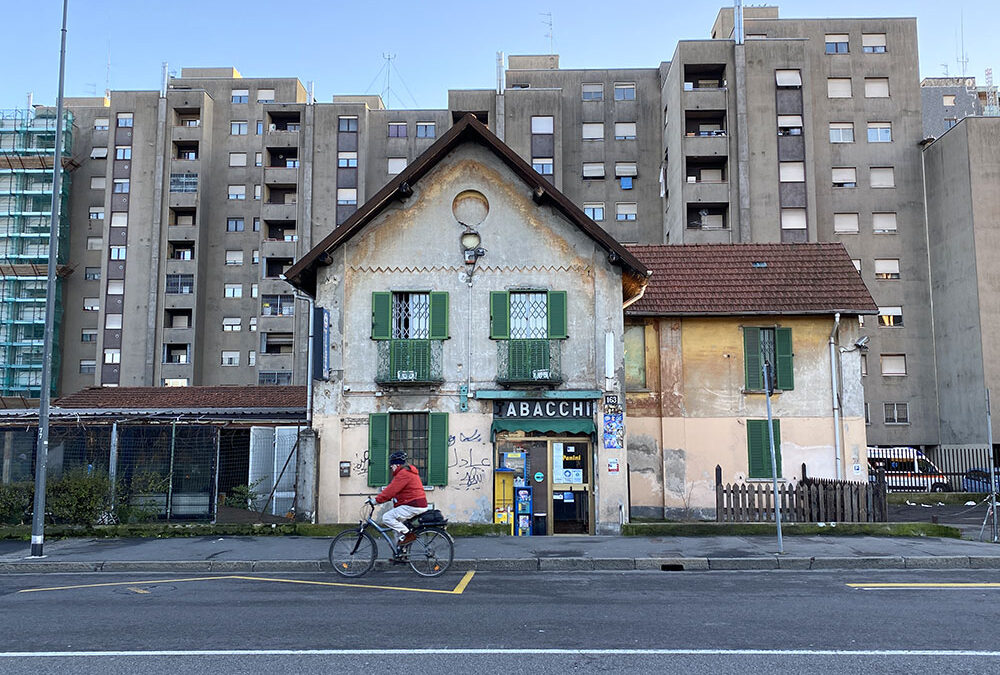
by Maureen | Jan 15, 2022 | Blog, Discoveries, Featured Articles, Italy, Milano
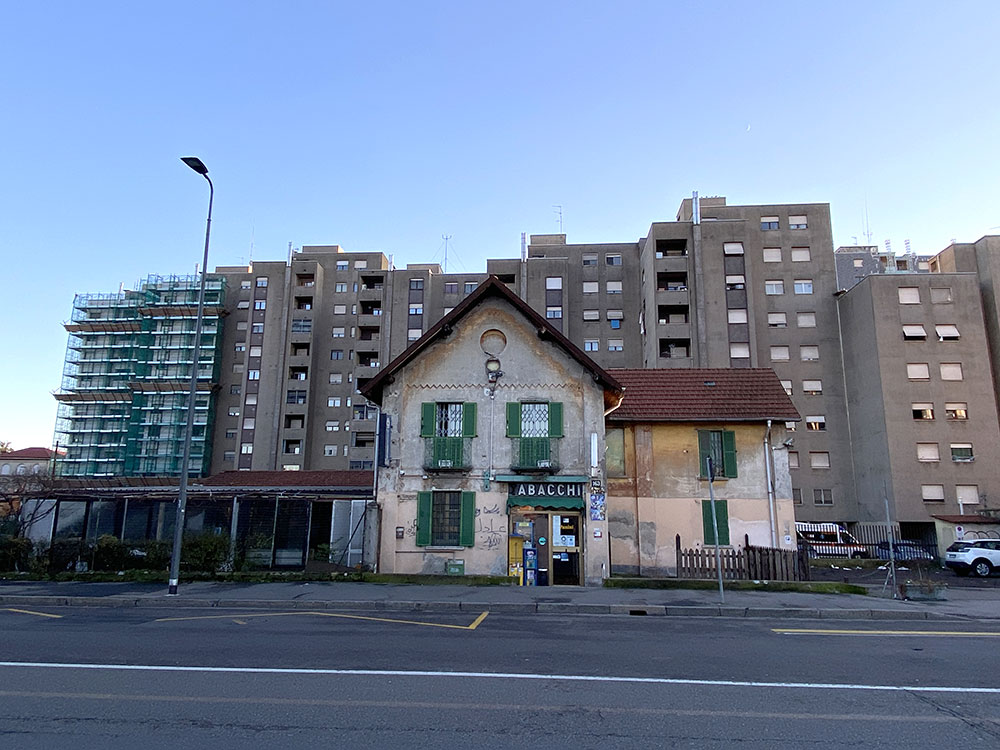
When a photo of this little building popped up on the Milano per Sempre Facebook page (Jan. 5, 2022), I thought, “I’ve got to go see that!” The age and “flavor” of the Trattoria Villetta Bar caught my eye.
The next day, I took the Metro out toward the end of the line, at Fermata Inganni, then mistakenly walked a very long loop until I finally arrived at my destination. (Google had misguided my walking direction, but in the process, I saw an area of Milan I had never been to before.)
There were several people at the bar, and we started chatting about the building’s history. Salvatore, a local, and I walked outside to chat. He has lived in the neighborhood for 50 years, and told me about his childhood memories of the surroundings.
In Italy, a “bar” does serve alcohol, but it’s where you go for a “caffè normale” – shot of espresso – as well as a pastry and fresh-squeezed orange juice. It’s often combined with the “Tabacchi” designation, where you can also buy cigarettes, add to your cell phone minutes, or get transit tickets.
Read, below, the original post from Milano per Sempre’s Facebook page,
in Italian, and Google-translated into English.
Questa caratteristica e graziosa casetta adibita a trattoria/tabaccheria è un retaggio di ciò che riconduce a Cascina Creta (“La Crea” in dialetto),un antico casale le cui tracce compiano con certezza sulle Carte del Fieno del Claricio dal 1659, e che prese il nome stesso dall’argilla che si estraeva presso le cave delle campagne circostanti.
Il complesso rurale era circondato dalle acque del fontanile Marcione che irrorandone i campi utilizzati per le coltivazioni,permetteva alle varie aree di essere raggiunte solo tramite dei ponticelli,donando alla cascina un aspetto associabile ad una rocca fortificata.
Sul finire degli anni ’30,la cascina venne spostata in una struttura più moderna, denominata poi “Creta Nuova”.
Pressappoco ad inizio del Novecento risale anche questo piccolo edificio assomigliante ad una baita di montagna,eretta su quella che era la strada per Baggio,ora Via Forze Armate 163.
Il suo impiego principale ero quello di stallo per le carrozze ed i cavalli che dovevano raggiungere le fattorie situate nella zona. Provvista di due campi da bocce,oltre che un luogo di ristoro offriva anche uno svago per gli avventori.
Negli anni successivi cadde in disuso e dagli orti limitrofi,si passò ad un lento degrado della zona circostante,in cui si trovava anche un rottamaio (“rottamat” in dialetto milanese).
Ora rimane questa immagine architettonica tra le più iconiche, nonché da salvaguardare nel bel mezzo delle case popolari, per gli amanti della vecchia Milano e di ciò che riguarda la sua storia.
This characteristic and charming little house used as a trattoria / tobacconist is a legacy of what leads back to Cascina Creta (“La Crea” in dialect), an ancient farmhouse whose traces have been traced with certainty on the Claricio’s Hay Cards since 1659, and which the name itself from the clay that was extracted in the quarries of the surrounding countryside.
The rural complex was surrounded by the waters of the Marcione fountain which, by spraying the fields used for cultivation, allowed the various areas to be reached only by means of bridges, giving the farmhouse an aspect that can be associated with a fortified fortress.
At the end of the 1930s, the farmhouse was moved to a more modern structure, later called “Creta Nuova”.
This small building resembling a mountain hut also dates back to about the beginning of the twentieth century, built on what was the road to Baggio, now Via Forze Armate 163.
Its main use was as a stall for carriages and horses that had to reach the farms located in the area. Equipped with two bowling green, as well as a place for refreshment it also offered entertainment for the patrons.
In the following years it fell into disuse and from the neighboring gardens, there was a slow deterioration of the surrounding area, where there was also a scrap dealer (“rottamat” in Milanese dialect).
Now this architectural image remains among the most iconic, as well as to be safeguarded in the midst of public houses, for lovers of old Milan and what concerns its history.
@nebulosa_simonastucchi
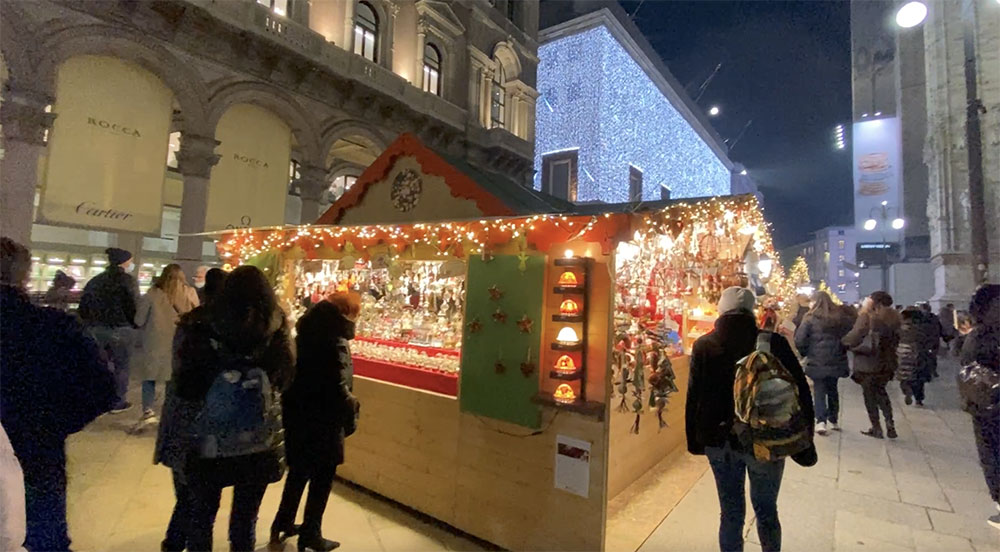
by Maureen | Dec 18, 2021 | Christmas & New Year's Eve, Featured Articles, Milano, Shopping & Markets
Stretched out along the north side of Milan’s Duomo, Christmas Market stalls are selling meats, cheeses, breads, pretzels, truffles, dried fruit, candies, chocolate… Also every variety of gift item, including little trinkets, clothing, ornaments, jewelry, etc.
Approaching the Christmas Market stalls.
Dried and candied fruits of all sorts.
Chestnuts roasting on a closed fire.
Meats and cheeses from Norcia.
Olives, pickled artichoke hearts and veggies from Puglia.
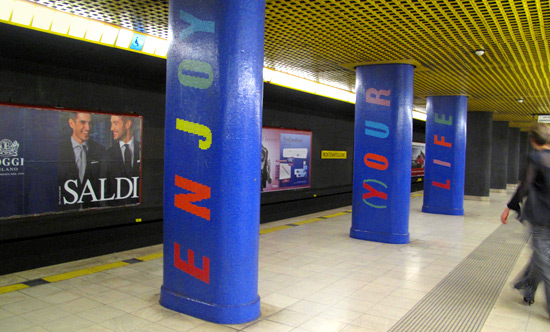
by Maureen | Jun 6, 2011 | Featured Articles, Incredible Locations, Introspection, Journal, Milano, Photos, Quips
What started all this exploration of Italy? A nudging query from a friend. An internet search. And far too many reminders that life is much too short. Too many friends and family members have “had their numbers come up”. They’ve gotten “that news”. It’s a gulper and has rattled me each time.
They say you can’t learn from someone else’s life. I want to refute that and take their news as a lesson to put as much life in my life as possible.
When on the metro here in Milano, on those occasions when I stop at “Fermata Montenapoleone“, I enjoy the tilework on the columns, and it reminds me to enjoy my life.
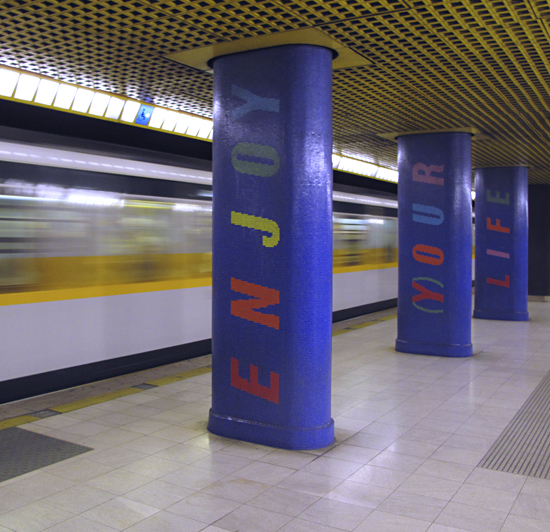
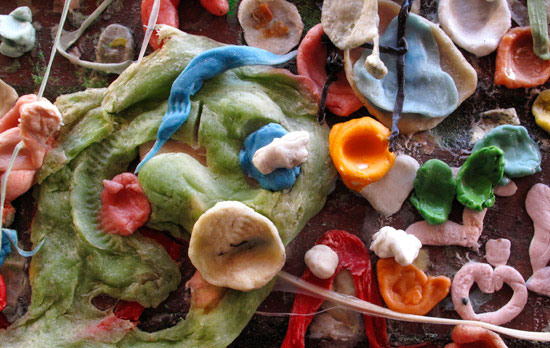
by Maureen | Oct 21, 2010 | Design, Discoveries, Featured Articles, Food!, Incredible Locations, Journal, Meals, People, Photos, Seattle, Shopping & Markets
As a designer and photographer, one of the most stimulating aspects of being in Italy was its visual lushness. Every surface and every structure caught my eye. (Hence, the 16,300 photos I shot in my almost-14-months there!) Before leaving Milano, I told a few friends back home that I was concerned I’d be visually bored once I returned to Seattle.
One friend, David, “The Computer Guy”, offered to take me on a tour of 100 quirky and wonderful things to see in Seattle. It would be a way of seeing Seattle, my birthplace, with fresh eyes. Now that I’m finally coming up for air from resettling, and blessed with blue sky Fall days here, we had our tour last Friday.
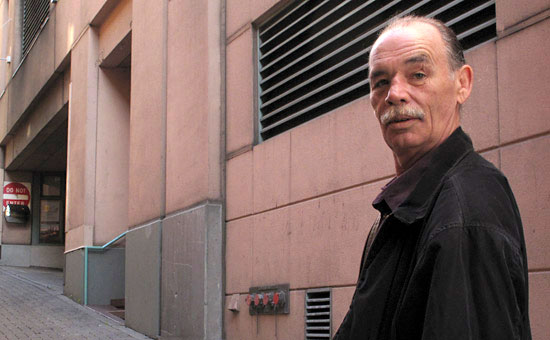
David and I met up at the International Fountain at the Seattle Center, ready to begin our 4-hour, fast-paced whirlwind through the city. (This is a tour he used to make with his son when he was little.)
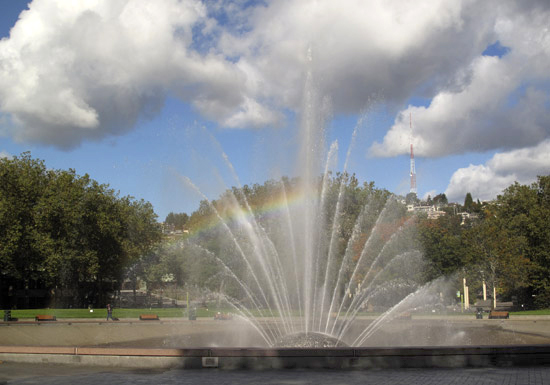
After checking out the rainbow arching over the fountain, we walked through the Center House food court to the Monorail entrance. We bemoaned the absence of the old Bubbleator that used to rise through the middle of the Center House floor.
It’s been years since I’ve taken a ride on the Monorail, and I’ve never made the trip as it now passes through EMP-Experience Music Project/Science Fiction Museum, designed by architect Frank Gehry.
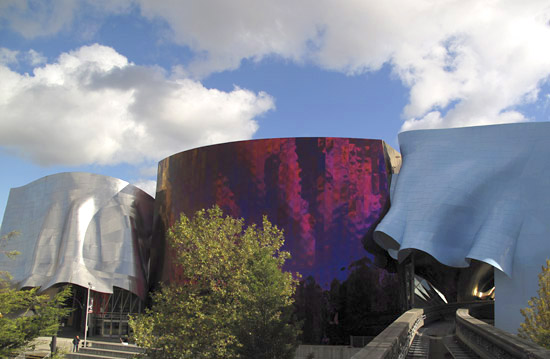
.
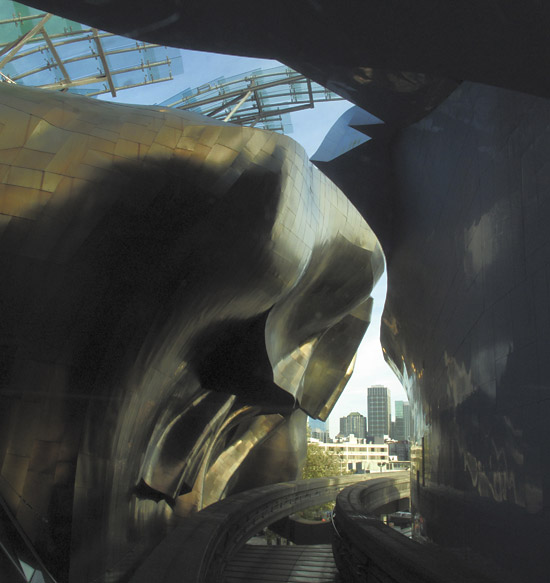
The Monorail’s elevated tracks snake the short distance from the Seattle Center in the lower Queen Anne neighborhood, into the city, past the “Darth Vader” building (on the right, below). (Seattle also has the “Norelco Shaver” and “Ban Roll-On” Buildings, named for their evocative shapes.)
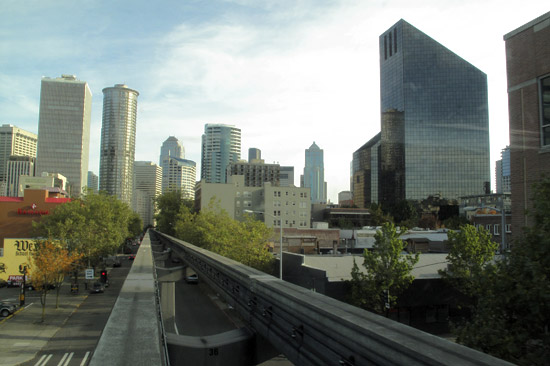
After a short ride, we arrived at Westlake Center, a 4-story shopping hub just a few blocks from the Pike Place Market. We wound through the lunch crowd for a quick pit stop before we began at Westlake Station for our ride through the Seattle Transit Tunnel.
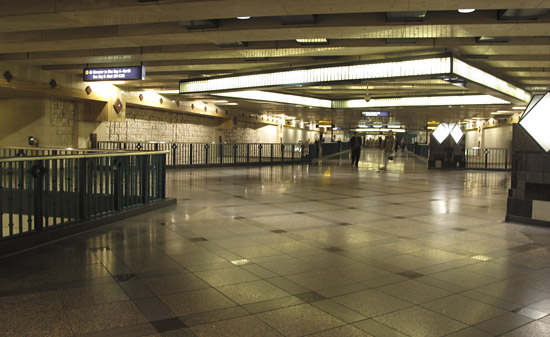
Every tourist and every local should take a free ride through this well-rendered tunnel.
From King County’s Web Site: “The tunnel has five stations. One of the first mysteries of station design was which came first, the art or the architecture? It’s difficult to separate the two. That’s because a lead artist worked with a lead architect to develop the distinctive art and architecture for each station.
“Metro eventually commissioned 25 artists to create more than 30 artworks for the tunnel, stations, surface streets, and sidewalks. The artists worked with Metro’s tunnel project consultant-Parson Brinckerhoff Quade and Douglas Inc. and architecture subconsultant TRA. Together they created the ‘art-itecture’.
“Each station is a representative slice of the neighborhood it serves. The architects and artists wanted people traveling through the tunnel to know where they were below the city by looking at the architecture and design features of the station they were in.
“The designers achieved that goal by studying surrounding businesses, buildings and uses, then creating designs reflecting those elements. Some features are subtle, and others much more noticeable.”
Design and aesthetic details found in the Transit Tunnel are too numerous to list. The roster of artists and architects, and their contributions, is lengthy. There is both “Art with a capital A”, as well as visuals inconsequential to most but artful to me.
(Click through the left-hand side navigation on this Station Art page to read discussions about the art and treatments of each transit station.)
At the University Street Station, beneath Benaroya Hall, is “Saccodoscopoeia” by Bill Bell, perhaps the most intriguing thing I saw all afternoon. Easily dismissed as just a granite wall with vertical rows of LED lights, with a little further exploration, this piece surprises the mind and eye with imagery and words revealing themselves through a “persistence of vision” trick. Move your head back and forth quickly and Seattle-specific icons appear, hovering in front of the wall. David’s trick is to stand 20 or 30 feet away from the wall and twirl on your toes a couple of times. The resulting dizziness causes the eyes to flicker and the images appear readily! (I was amused to think of the security cameras capturing our spinning in circles.)
Here’s the wall, at a glance. When I stood close to the lights and held my camera up, the images flashed quickly in my screen several times, but I wasn’t successful at getting a shot.
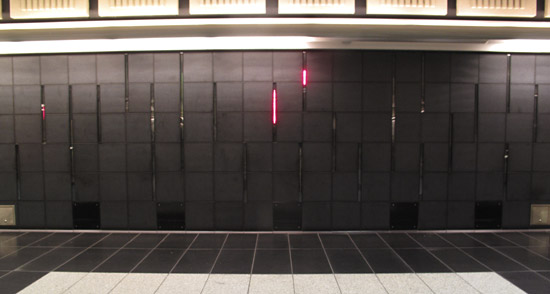
We saw big clocks, distinct at each station and all set to high noon. I appreciated the stenciled compass roses painted on the roadway. How appropriate and helpful for knowing “which end is up”.
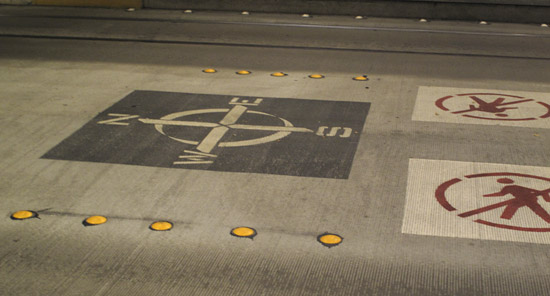
Benches, of course, are all “sit but don’t lie” in their design, discouraging naps and nighttime lodging by those without a better place to sleep.
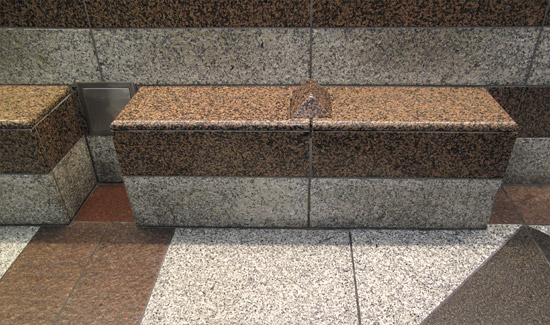
Though each station features distinctly different artwork, one element that unites all stations is the sandblasted braid created by artist, Norie Sato. It’s meant to be part of the cueing system for the visually-impaired, but I found it so subtly low-relief that I question its effectiveness for that purpose. I loved it’s visual addition to the tunnel stations, though. And the varied, patterned stone paving reminded me of what I’ve seen in Italy, France, China and Nicaragua. I’m all for visually-rich floors, sidewalks and roadways instead of monotonous gray concrete expanses.
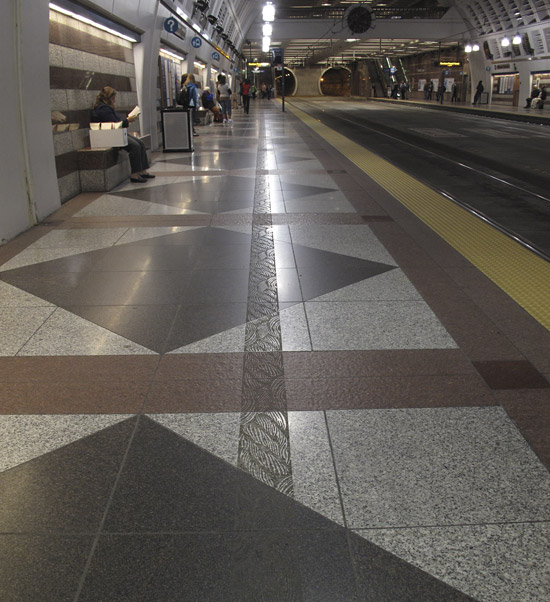
We rode Metro through the tunnel from Westlake Station to the International District, popping up at the other stations along the way. Rising up out of the tunnel at “Chinatown“, poetry was sandblasted into the stair risers. This word “venture” seemed appropriate for our day’s tour.
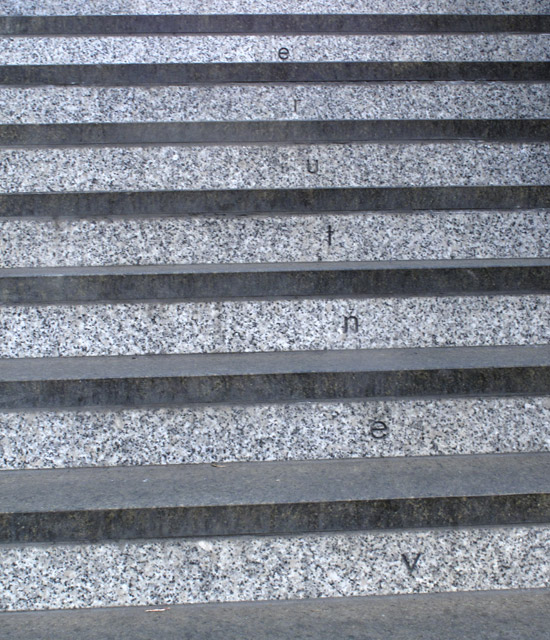
Immediately out of the station, we were greeted into Chinatown by the 45 foot high Chinese Gate, completed in December of 2007, and adorned with the characters saying “Zhong Hua Men”, meaning “Chinese Nationality”. It is typical of the traditional city gates of China and reminded me of a gate I photographed in Xi’an, China, years ago.
We were on a mission, heading to one of David’s favorite spots in Seattle, Liem’s Pet Shop in the Maynard Alley. Unfortunately, they were closed, so there was no visiting with the diverse menagerie.
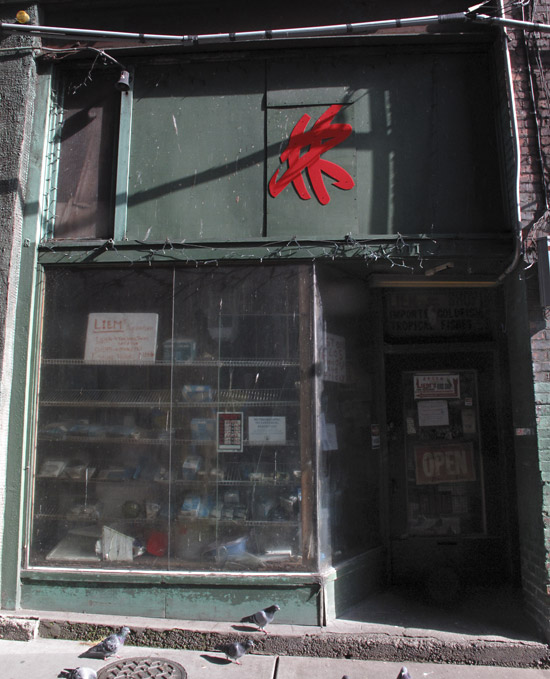
We wandered around, smelling good food, but not stopping to eat. (Why?) We passed the relic of an old dim sum shop and stepped into an art studio and gallery on Jackson Street. The painter’s calligraphy had a sort of Parkinsonian jitter to it, which made it quite distinct.
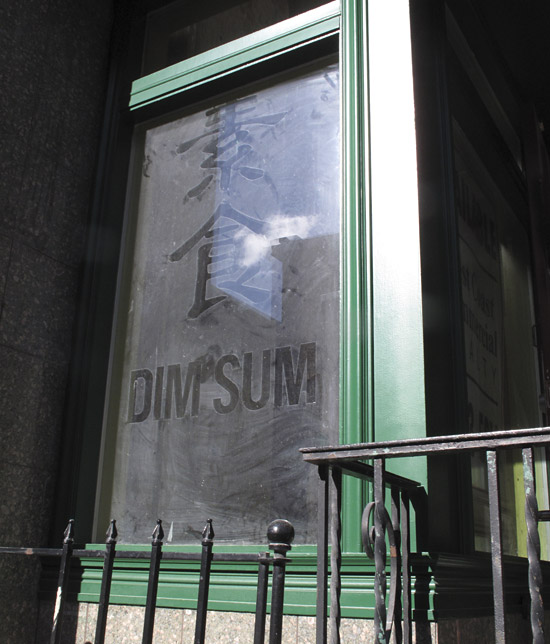
Though contemporary, this poster harkens WAY back.
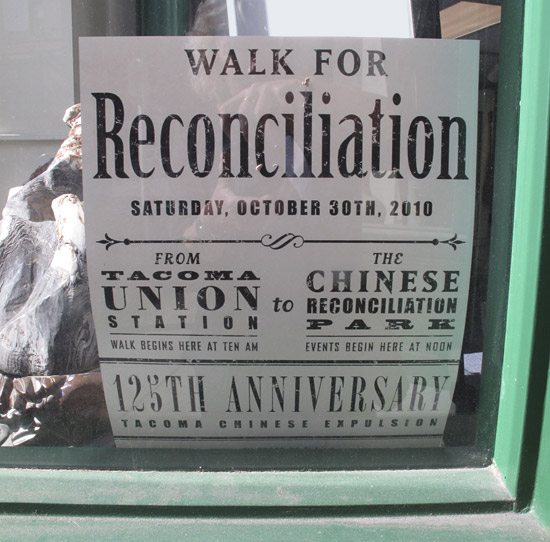
We returned to the station, reboarded Metro, and headed north back through town. Intending to get off at University Street, we overshot our stop and so, got off back at Westlake Center. We arose to street level and walked over to the Rainier Tower, designed by Minoru Yamasaki. It was completed in 1977, and I remember that people were freaked out because it appears to be like a pencil standing on its point; all were convinced it would fall over.
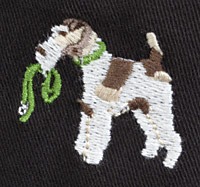 There is a long tunnel under the Tower, filled with historic photos of Seattle, Boeing and the local neighborhoods. After coming up from under the Rainier Tower, we started walking toward the waterfront along Union Street. One of the most ridiculous things I saw on our tour was a pair of pants displayed in the window at Brooks Brothers. They were embroidered with silly little doggies from top to bottom! Tell me, WHO would buy such pants? (Who would conceive of them and put them into production?!) Seeing these pants in the window stopped me in my tracks and had me laughing. Looks like this dog has his leash and is ready for a walk.
There is a long tunnel under the Tower, filled with historic photos of Seattle, Boeing and the local neighborhoods. After coming up from under the Rainier Tower, we started walking toward the waterfront along Union Street. One of the most ridiculous things I saw on our tour was a pair of pants displayed in the window at Brooks Brothers. They were embroidered with silly little doggies from top to bottom! Tell me, WHO would buy such pants? (Who would conceive of them and put them into production?!) Seeing these pants in the window stopped me in my tracks and had me laughing. Looks like this dog has his leash and is ready for a walk.
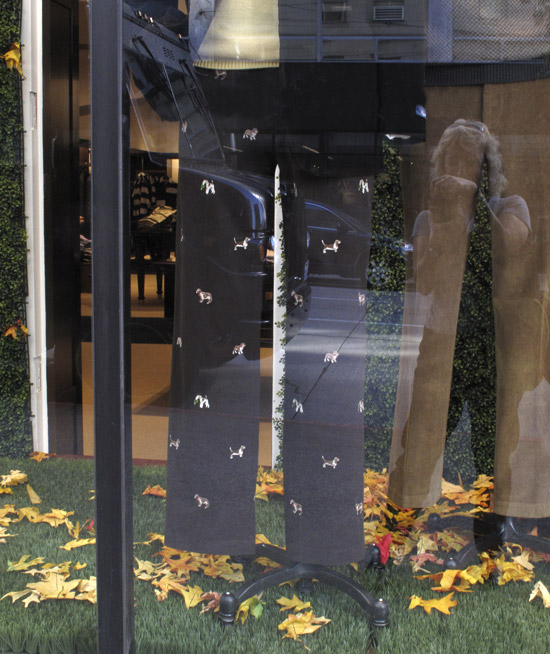
Here’s a job for the not-s0-faint-of-heart… We looked up and saw window washers on a beautiful afternoon.
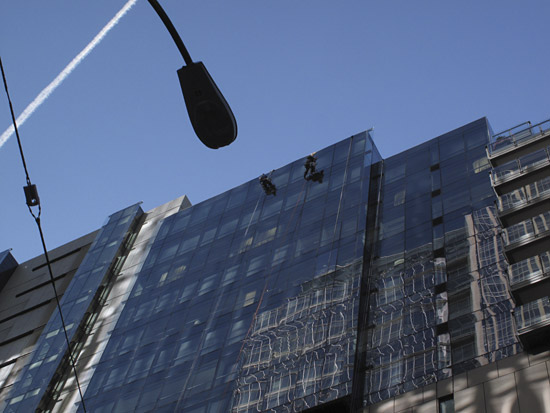
At the west end of Union Street is one of hilly Seattle’s many stairways, this one leading down toward Western Avenue and the waterfront. We climbed down, arriving at the Seattle City Light power station with its metal, floral-reminiscent barrier (instead of razor wire), and then stepped into the south end of Post Alley.
Arrive at… The Bubble Gum Wall! David had told me about it months before leaving Milano, so I was looking forward to seeing it, to which he responded: “You have blown it up beyond all expectations. It is only a 20 foot section of a brick wall between two doors on a brick roadway, with 30,000?? bubblegum wads up to thirty feet from the ground, in every color imaginable, with sculptures of gum and inserted objects. That’s all.”
The Bubble Gum Wall is at the south end of Post Alley at the Pike Place Market, accessed through a short “tunnel” roughly under The Pig by the flying fish stall.
It’s grown since David last saw it, and far outmeasures his 20 foot estimate. It’s a draw for tourists and locals alike. One girl was taking a picture of her friend who wanted to LOOK like she was licking the wall, but was terrified of accidentally touching her tongue to the wall in the process. This is THE place for portraits, cell phone cameras always at the ready.
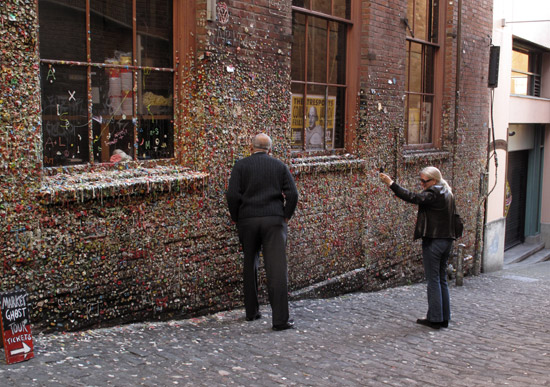
.

What is any city without it’s share of graffiti? Love it or hate it, there are times when it’s just plain gorgeous. This is rich like fabric, with its step-and-repeat stencil.
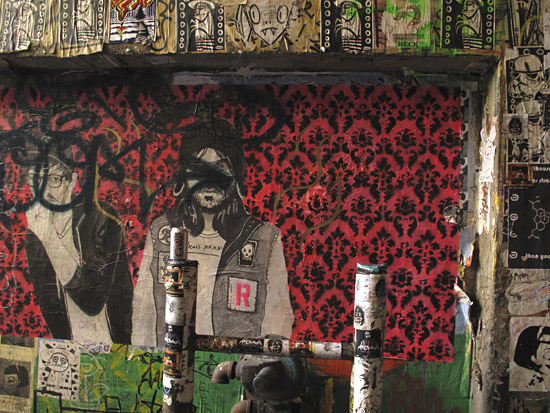
Of course, after covering Seattle, end-to-end, on foot, it was time for another pit stop and the Market was a perfect spot. There are several public restrooms hidden in the rabbit warren maze that is the Market. We went to the two that are just down the stairs from the flying fish. Black and white tile male and female figures stand outside the doors. Inside the doorway, the icons become more scientific: “XX” and “XY” figures indicate gender. (I wonder what percentage of the population knows the significance of those letter combinations.)
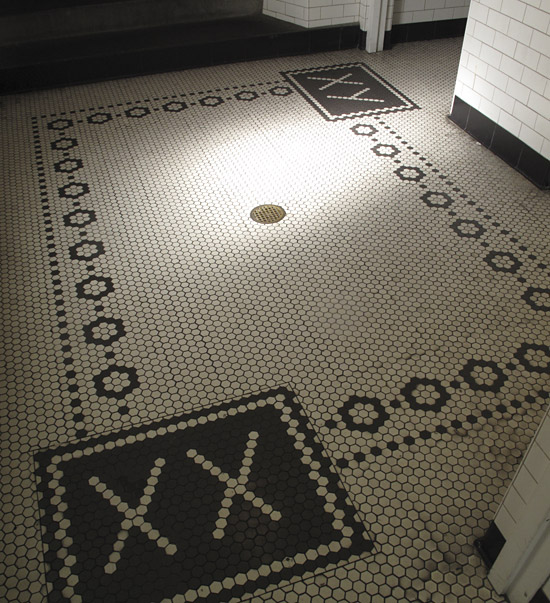
And it wasn’t until I was leaving that I realized that the wall tiles inside the bathrooms form Morse Code! Too bad I didn’t photograph the whole message.
(Update, December 21, 2010. The last time I was at the Pike Place Market (a couple weeks ago) I went back into the restroom and wrote down the full morse code message. I had only photographed the first portion of it before, which was enough to guess the meaning, but my second visit confirmed it: “Meet the producer.” Ahhh. That’s what it says over one of the fruit stands, regarding meeting and buying directly from the growers. How many people have 1) ever noticed that it’s Morse Code, and 2) if they’ve noticed, have decoded the message?)
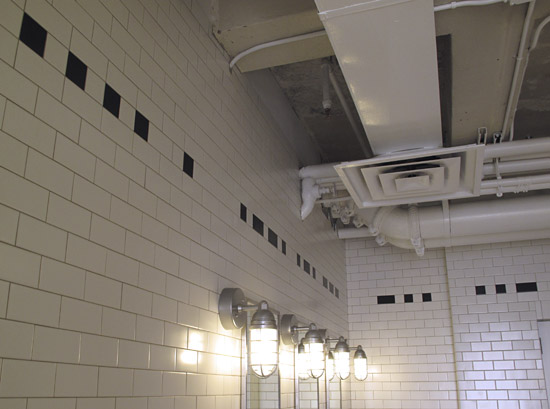
Time for a mid-afternoon bite to eat while we strolled: a half-dozen deep-fried morsels from the Daily Dozen Doughnut Company (right across from DeLaurenti’s). They tumble directly out of the hot oil, and into bowls of powdered or cinnamon sugar.
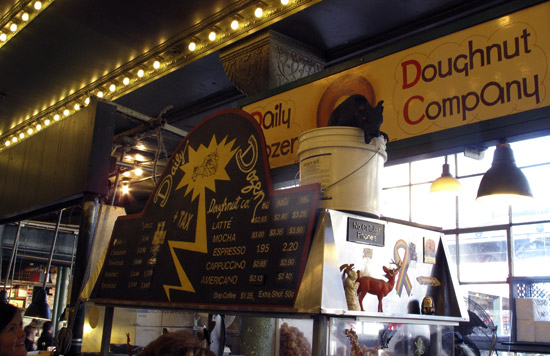
Gobbling piping hot doughnuts, we wandered to Tenzing Momo… a neighboring toy store… the belly dancers’ clothing store… and the Magic Shop. I’d been wanting to buy one of those trick balls that won’t roll in a straight line but rather wobbles aimlessly. (It’s a physical representation of how I’m feeling these days, still needing to re-establish my direction.)
This was my second Magic Shop in less than a year! The other one was Mayette Magie Moderne in Paris at Christmas time. Don’t you love the drawers of treasures in an old magic shop?
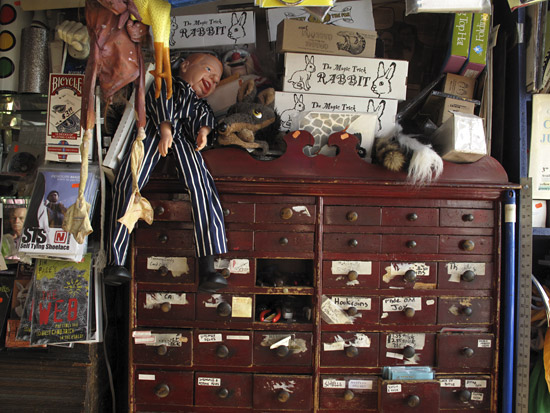
As a teenager I used to go to the Pike Place Market and wander its historic “bowels”… the many unlevel walks, ramps and stairs leading to tucked-away shops selling oddities. I still have the long strand of glass African trading beads that I bought for a quarter each. They’re worth a fortune now.
The Giant Shoe Museum is marked by a great example of the classic circus-style bills.
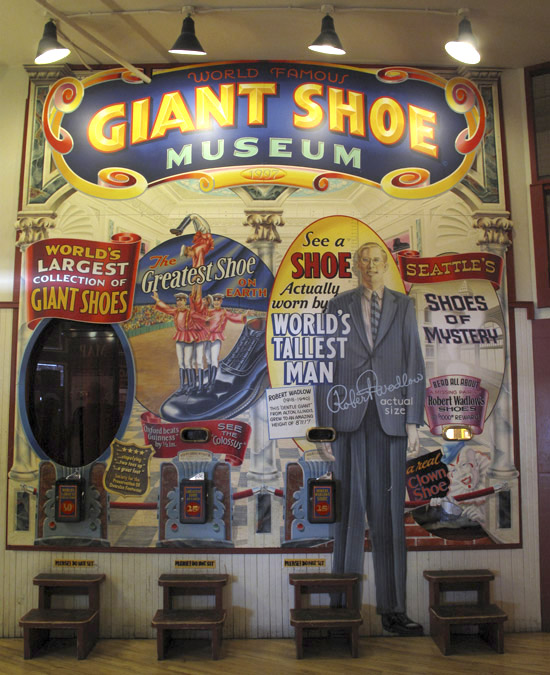
I’m amused by the visual treats that we encountered from one end of our Seattle tour to the other. Look at this light fixture near one of the Market stairways. These touches add humor and visual flavor to a city.
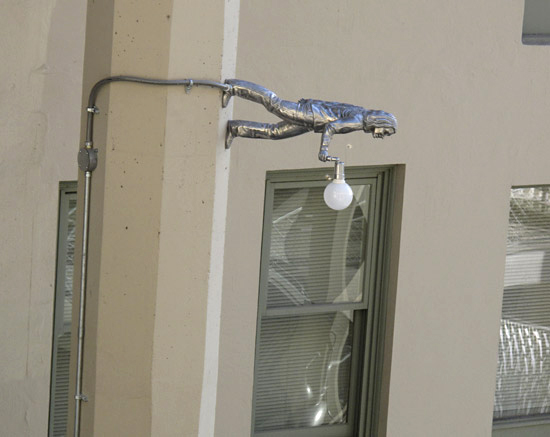
After our doughnuts had settled and we had walked past the endless food, craft and flower vendors, it was time for a real lunch. David took me to the Piroshky Russian Bakery, where we bought smoked salmon piroshky.
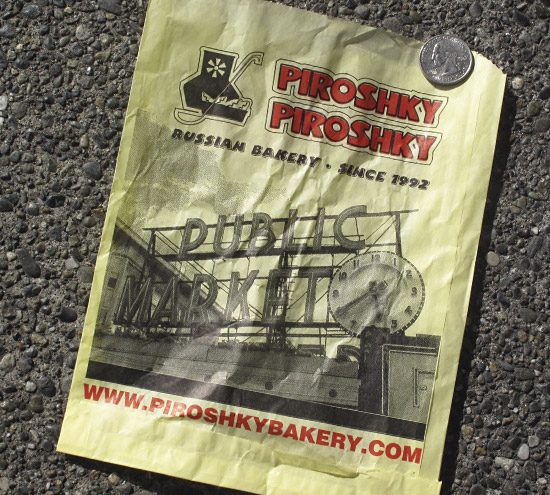
We walked to the wall-mounted tractor seats and perched there to eat and chat.
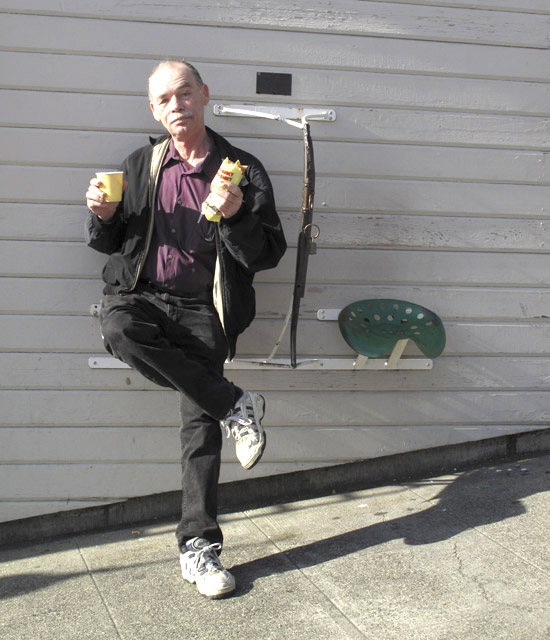
The tour was winding down, and we walked back over to Westlake Center where there was a giant chess game in progress. The fountain (to the left, below) was now flowing, so we both splashed through the tunnel of water. It’s a good thing I had put my camera away beforehand! It was much wetter than David had remembered, and I was drenched afterward.
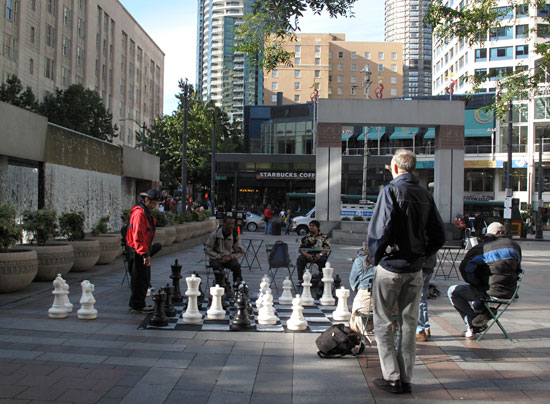
We had lucked out with a sunny, fresh Autumn day in Seattle. David and I stood on the south balcony of Westlake Center’s food court and watched the people go by.
The paving pattern is derived from a Northwest Coast Salish basket from the collection of Dr. Allan Lobb, first executive director of Swedish Medical Center (now deceased). He was the one that let me walk out of his condo 20 years ago with 4 of his 100-year-old baskets to use as photographic references for my paper models. I am thrilled every time I see this broad and beautiful paving that enlivens this plaza and roadway. (It reminds me, again, of the foreign pavers I’ve loved.)
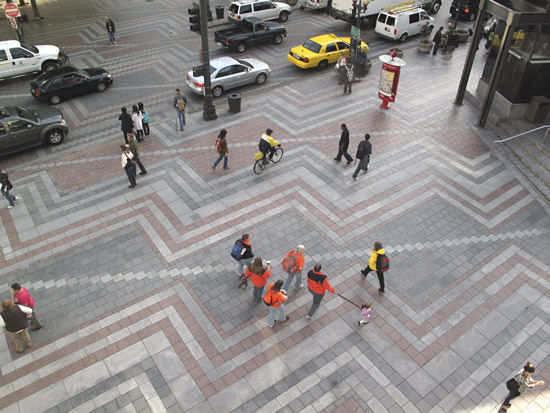
OK. Tell me. WHY would a woman be walking through the middle of downtown Seattle carrying a lifering?
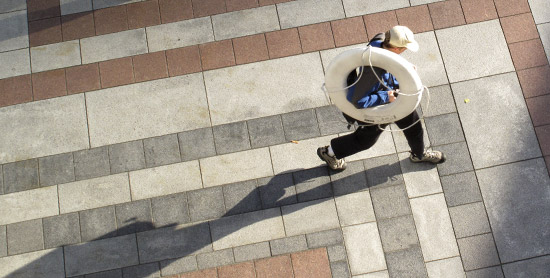
Seattle cops have two types of saddles to choose from.
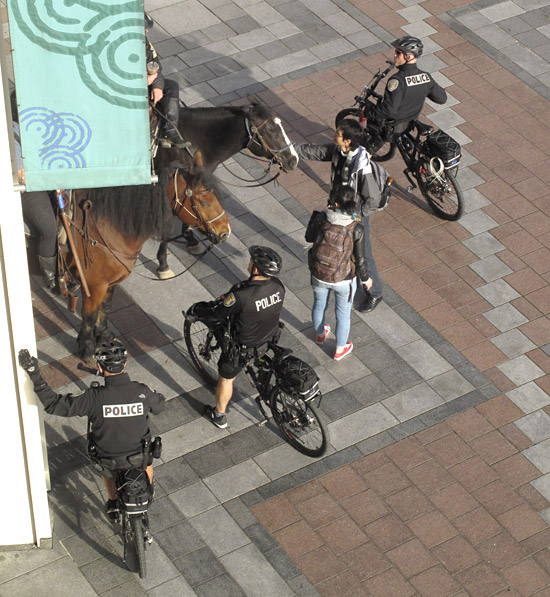
We rode the Monorail back through town, hovering over the city streets, and emerged again through EMP. The afternoon light bounced off the deep violet tiles of the museum, and colored the structures across the way. The tour was finished with a slow amble around the Seattle Center, viewing the scattered artwork in the shadow of the Space Needle.
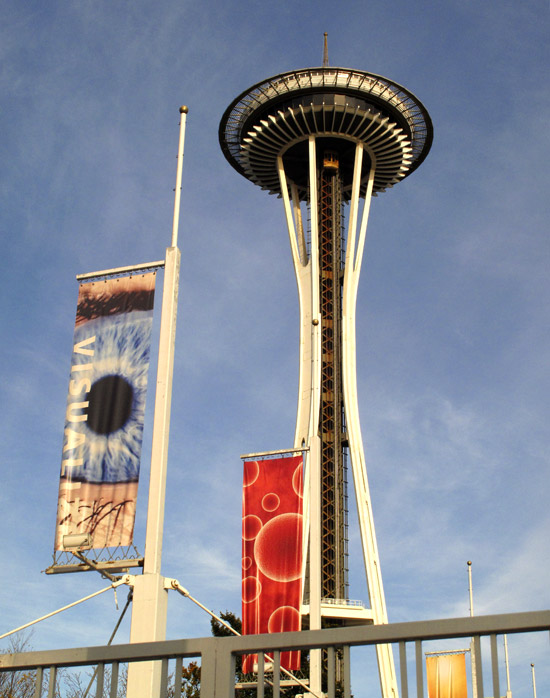
I was leaving town on a Friday evening at 5:00, getting onto the Viaduct with the rest of traffic. It reminded me of why I’m glad I no longer commute, but also pleased me with the waterside view, looking up from the roadway.
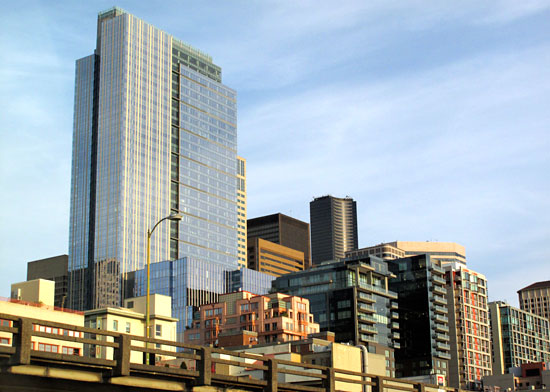
And my impression of Seattle after the day’s tour? There’s ART everywhere! “Art-with-a-capital-A”, and art in small, informal, spontaneous ways. With Seattle’s awareness of and commitment to Public Art, the city has created a visually rich flavor. Go for a walk with eyes wide open.
– – –
For those of you needing computer disaster prevention or rescue, get in touch with David. He’s saved me and my friends countless times over the years!
David Anders – The Computer Guy, Seattle
TEL: 206-286-8438 • davidanders@gmail.com • webpresenceseattle@gmail.com
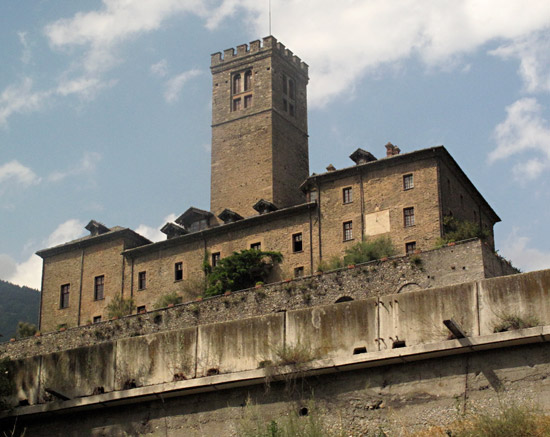
by Maureen | Jul 24, 2010 | Aosta, Incredible Locations, Journal, Photo of the Day, Photos
On Thursday, the bus pulled away from a 95 degree day in Milano and headed into increasingly blustery skies in the Valle d’Aosta at the far northwest of Italy. (Find it on the map here.) I shot a few crude images through the dirty, tinted bus window as we rolled along, watching the scenery and the weather change. We went from the corn fields surrounding Milano, to castles and mountainside vineyards.
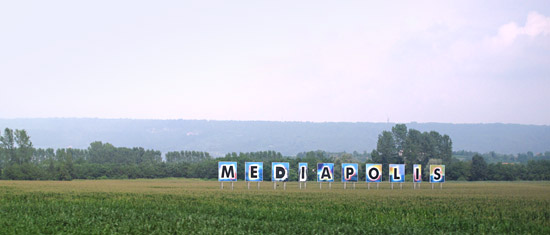
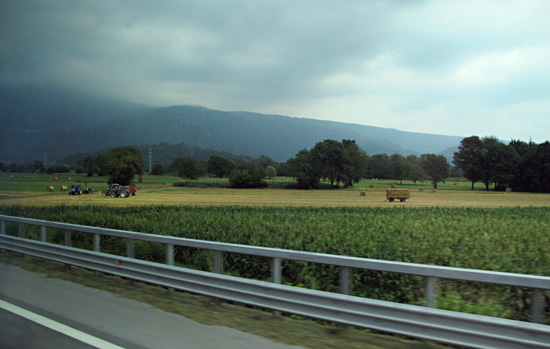
Today, two days later, on my return trip home from Cogne, the weather had changed and I sat on the north side of the bus to be out of the heat of the sun.
– – –
Some notes from my journal entries to-and-from:
22 Luglio, 1:00
Milano – Lampugnano. (One of the metro stops on the red line and a major bus transfer point).
Heading west to Aosta and Cogne to spend a couple of days with Ewa and Piotr. They were my first new friends here and I will say my goodbyes to them as they’re spending this month in the mountains.
The bus has just pulled away from the station.
From Aosta, I could throw a rock north into Switzerland or west into France. I could pitch it to the top of Mont Blanc. Great to have this opportunity to see another spot in Italy, one of its mountainous regions. This is part of my “Say Yes!” program: say “yes” to what presents itself.
(Late in the ride, this is the closest I got to a view of Mont Blanc, obscured by clouds.)
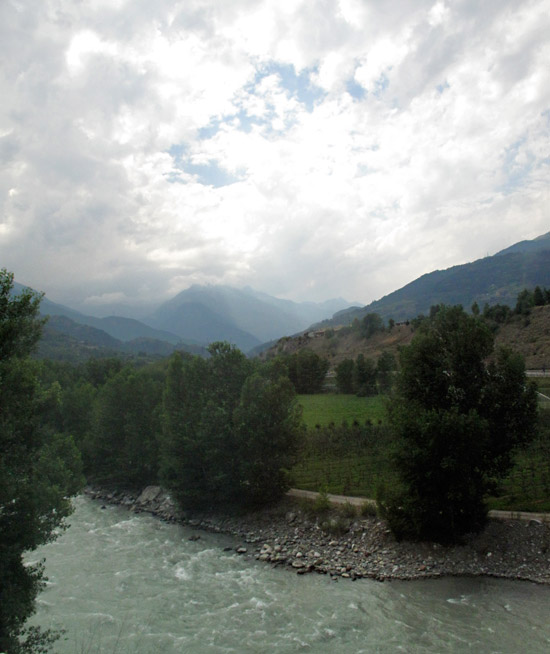
2:30
As we head deeper into the Valle d’Aosta, the proximity to Switzerland is apparent. The architecture has changed. Rooftops bear flat, gray slate instead of red tile.
(This very old rooftop has lost its distinctive fish-scale pattern as the slate has broken up.)
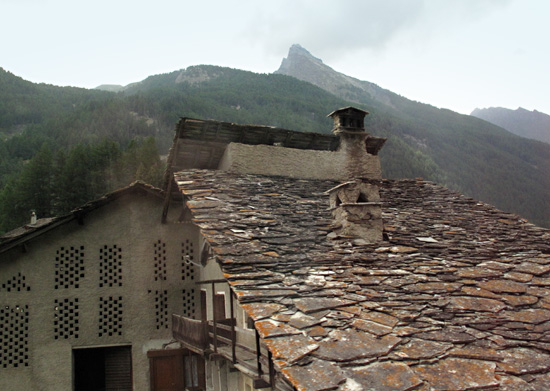
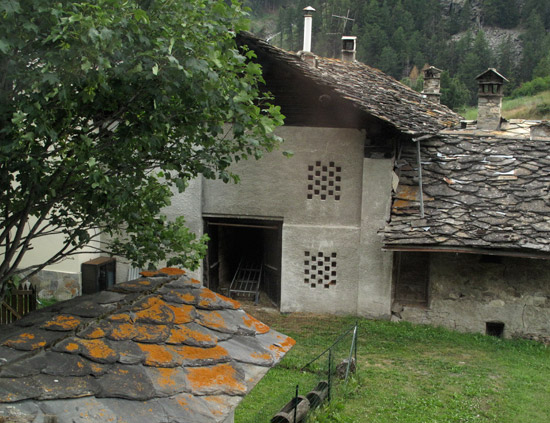
The mountains are steep at both north and south. Vineyards face southwest on steep slopes.
Castles sit atop high promontories. Lettering has changed to old gothic. I’m sure the language is different, too. The rivers are gray-green and opaque. (Language is the “secret, magic decoder ring” to other worlds.)
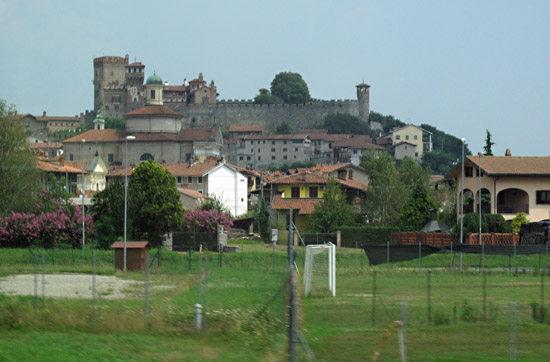

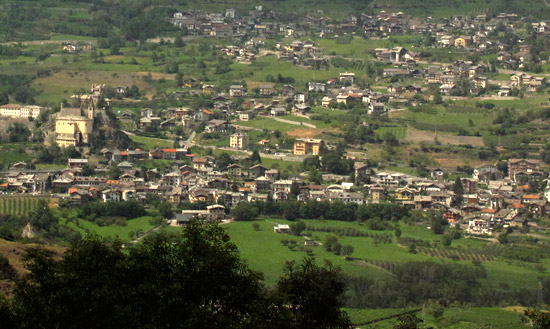
Aosta 3:15
Switch buses and then continue on to Cogne, (pronounced CONE-nyay) 50 minutes south, into the mountains. Signs are in Italian and/or French. Houses look like Americans’ stereotypical view of Swiss chalets, complete with decorations of gnomes and trolls. This is a different italy. Imagine how UNlike it is to Napoli and Sicilia!
This is a deep, narrow valley. Houses and farm fields climb the slopes to the north and south of town. An alpine community, certainly.
I think of their having united as one Republic less than 100 years ago (1946). About like binding New York City with Montana: separate worlds without commonality.
(“This way to beds in Europe.” Are Holiday Inns everywhere?)
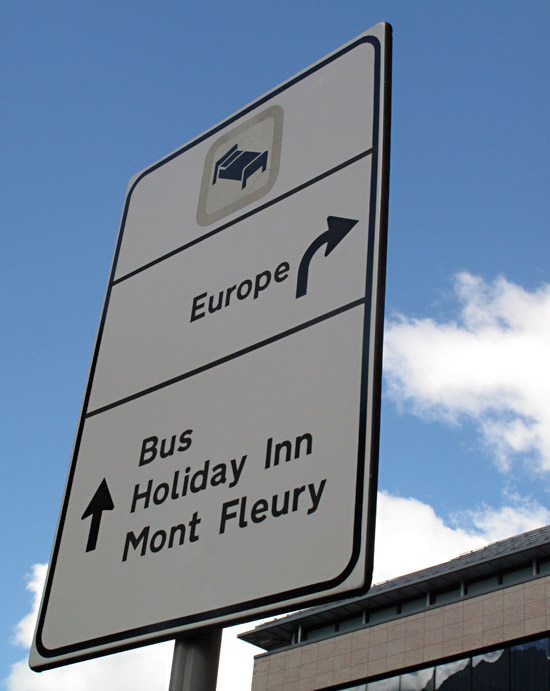
by Maureen | Jul 24, 2010 | Introspection, Journal, Quips
One week from today, at this time, I will have schlepped my bags by taxi and train to Milano Malpensa airport; checked in, with machine gun carrying guards in the mezzanine above me; gone through security; waited; flown over the Alps to London two hours north; gone through security again; eaten an airport meal; wound my way through Heathrow; boarded, gotten settled and begun my 9 hour flight back to Seattle.
I just went grocery shopping. What favorite foods do I want to eat again (and again) before I go? I bought bresaola, and mortadella with pistachios, buffalo milk fresh mozzarella, fresh figs and sicilian tomatoes. One (or two) more meals of octopus? Who do I want to see and say goodbye to? How many more last hurrahs with my girlfriends? Where do I want to go? What will wish I had photographed?
As I buy groceries and supplies this week, I have to calculate how much I can use in six days. As I go for a bike ride, or subway ride, I have to realize it may be the last one (for a long while).
From a journal entry today:
“I have grown a sweet affection for this country. It’s not the starry-eyed, naive enthusiasm of a tourist’s love of the sights. But it’s a complex recognition of the quirks, an all-too-recent connection with individuals along my path, the creation for myself of a way of being, and as yet, merely a hint of who these people are. How can I stay away for long? I am leaving a part of myself here, and have lodged a part of Italy in my heart, to carry with me. Under what circumstances will I return, and for how long?”
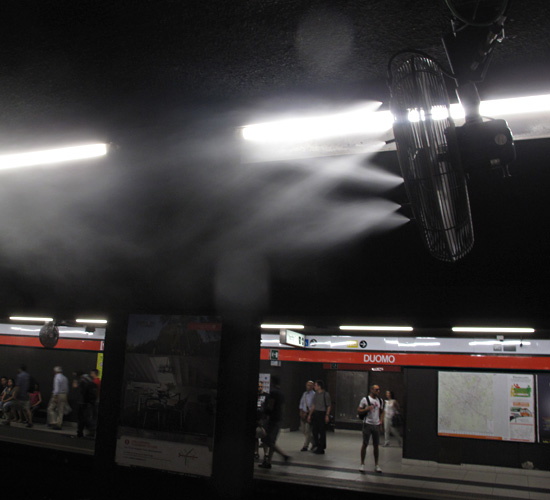
by Maureen | Jul 20, 2010 | Featured Articles, Journal, Photo of the Day, Photos, Quips
It’s been toasty-o here in Milano lately, with temperatures in the high 80s to high 90s, and humid. When I walk out of my apartment, it’s like walking into a sauna! I’m grateful to have air conditioning.
One solution I find at the major hub subway stations around town, is the installation of fans spewing a fine mist. It’s refreshingly cool…and mesmerizing.

.
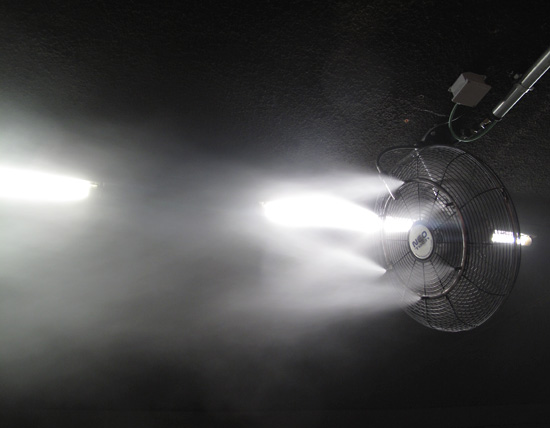
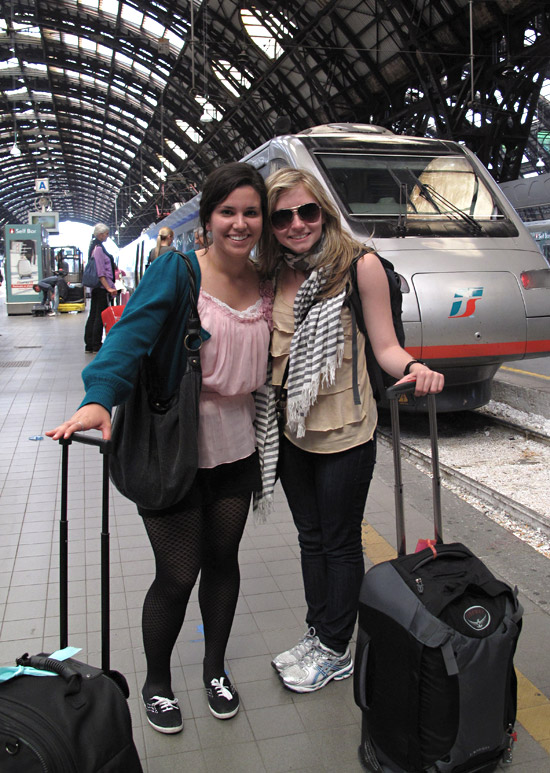
by Maureen | Jun 22, 2010 | Canals, Cheese, Discoveries, Featured Articles, Food!, Journal, Meals, People, Photos
The excitement of a college-time trek through Europe! Hannah & Zibby started together on June 8, in Newcastle Under Lyme. They went on to Amsterdam and Berlin, took a wrong train into Switzerland, and arrived in Milano yesterday. They’ll go on to Venezia, Firenze, Roma, then Athens and Santorini. A time to discover themselves and the world.
There’s always the charge of newness when arriving at a train station in a new, as-yet-unvisited city.

Following their afternoon arrival, we took off on both subway and foot for a whirlwind tour of the city. We wasted no time and stopped at the Spezia Milano Pasticceria, suitcases still in hand, to buy a tray full of the best pastries in the city.
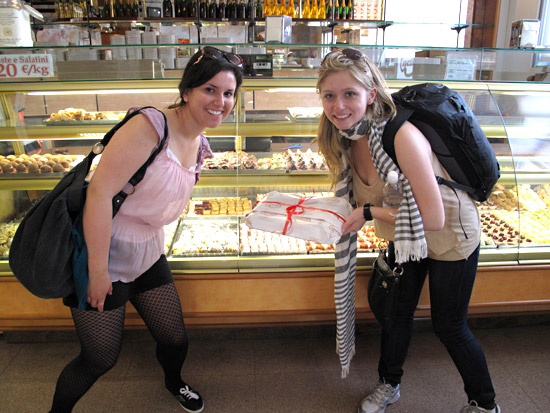
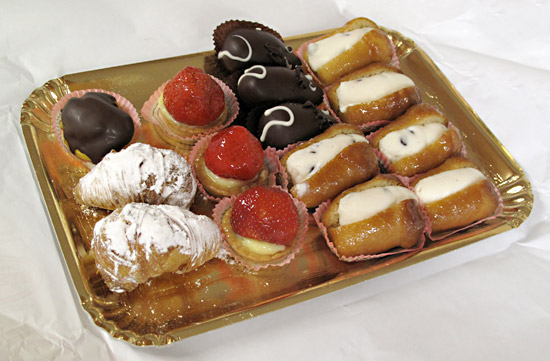
Trying a “BaBA” was a must for these girls and their yen for sweets. These little sponge-cake gems are SATURATED with rum, and filled with a sweet ricotta cheese with chocolate bits. The first bite sends a stream of rum down the arm and leaves a puddle of the alcoholic syrup in the little decorative paper cup. Tip the cup to sip every drop.
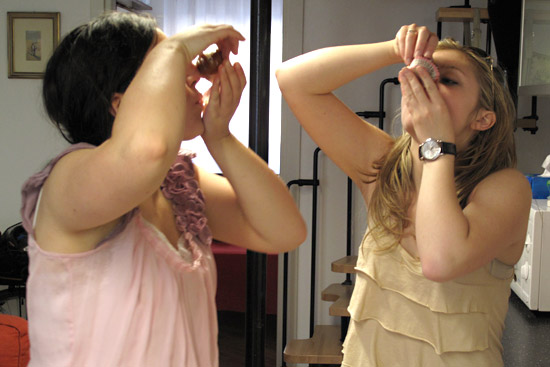
The girls freshened up after their overnight train trip, then we headed for the subway and back to the center of town: the Duomo. We studied the gargoyles, doors, and gory statues all over the church’s exterior. In addition to the pious saints and cherubs, there are pensive philosophers, ominous monsters, and poor unfortunates in all states of torture, beheading and disembowelment. We remarked on the many different artistic styles.
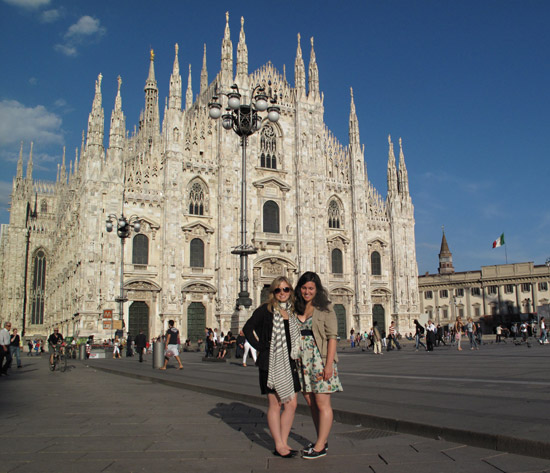
Of course we walked through the grandeur of the Galleria, a must-see for any visitor.
When out in front of the Palazzo Reale – the Royal Palace-turned-art-museum – we had a lesson in paving patterns, learning that, though attractive, the round, embedded pebbles were actually not very comfortable to walk on. That’s the reason for the inlay of broad flat stones.
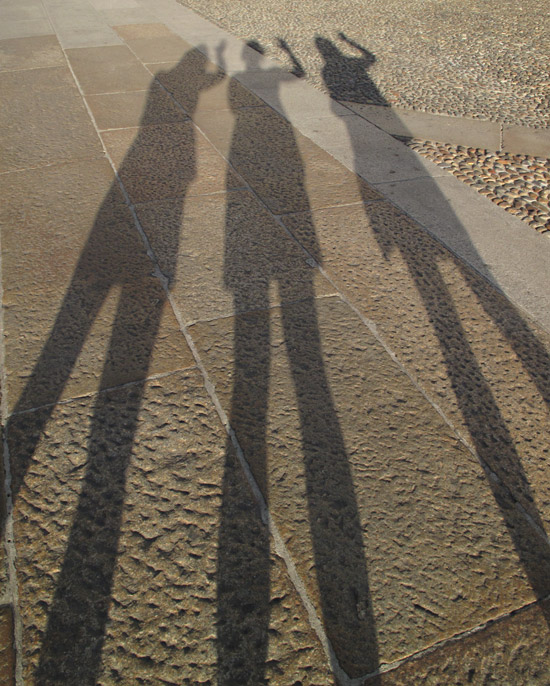
Throughout Italy there are water fountains in the major cities that provide potable water from natural, underground sources (or so I’ve been told). Locals and tourists alike refill water bottles, or take sips on a hot day. One man knew the trick of blocking the water flow coming out the bottom of the spigot, which then diverted the flow out through a small upper hole, creating a drinking fountain arc of fresh water. Hannah just had to test the waters.
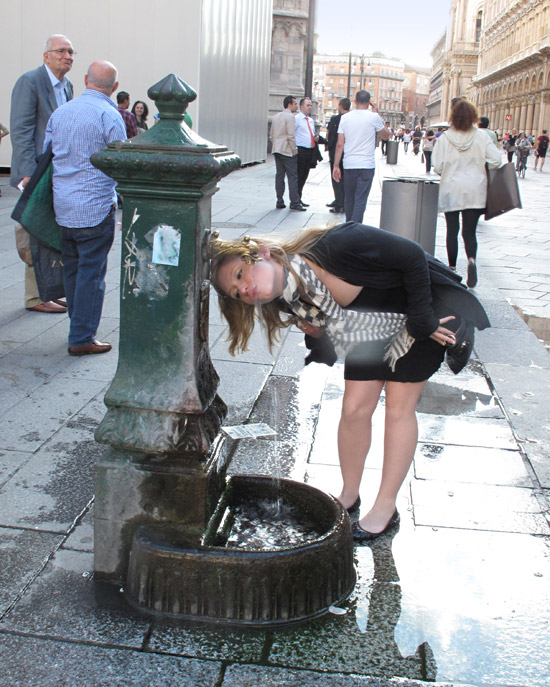
The tired travelers were getting hungry, so we descended into the subway maze, caught the red line, then transferred to the green line. We got off at Porta Genova to stroll through the Navigli – canal – district, the hip, energetic, trendy, scenic zone of antique fairs, flower markets and exhibiting painters. We had come for aperitivi, Milano’s traditional all-you-can-eat buffet for the price of one drink, usually 7-9 euro. We picked the restaurant on a floating green barge docked at the junction of the Naviglio Grande and the Naviglio Pavese. In addition to the usual carbs of pasta and pizza squares, they offer roasted peppers, eggplant and zucchini, balls of fresh mozzarella, and an amazing bruschetta of Italy’s summer-ripe tomatoes. A very nice Montepulciano and a strawberry mojito are what we selected for making our toast to being in Milano together.
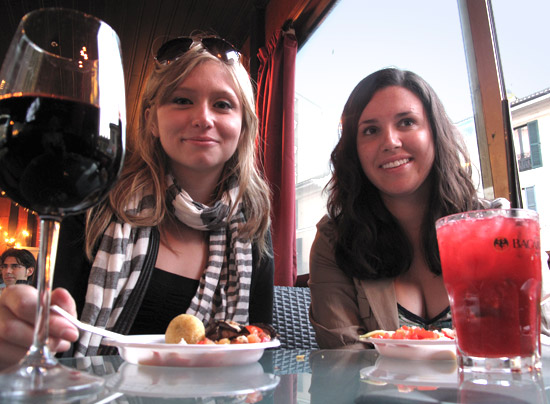
The collective sweet tooth reigned and our meal would not have been complete without a further stroll along the canal and a stop to buy gelato. Hannah and Zibby learned a lesson about design and merchandising. This particular gelateria has very nice signage and interior display… and a line of people out the door waiting to get in. A gelateria 3 doors down is NOT visually impressive and the place was empty.
I was proud of Hannah for ordering her gelato IN ITALIAN! “Vorrei stracciatella.” “I would like stracciatella” (A vanilla gelato with little bits of chocolate chip throughout).
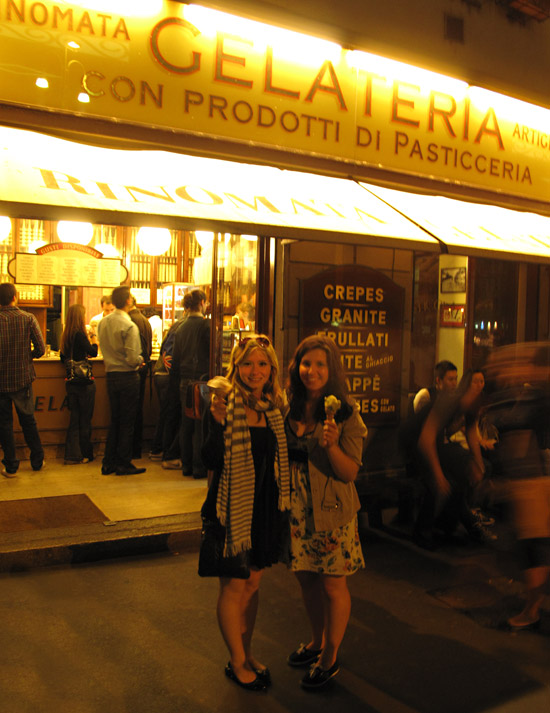
By 11 o’clock on a lovely, warm evening, we were walking along the smaller of the two canals amidst umbrellas, street musicians and candle light. We took a detour for a late night showing of some of Milano’s best graffiti, then headed home for a skype session with folks back home.
Hannah and Zibby were gracious, curious and great company during their personal tour of my Milanese haunts. They enjoyed seeing and hearing about some of the particular details of a “local”.
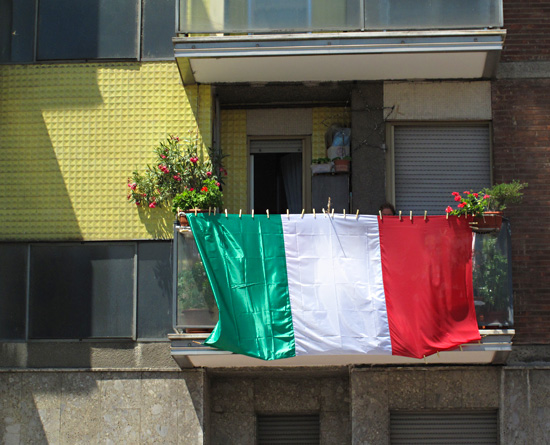
by Maureen | Jun 18, 2010 | Featured Articles, Graphics, Introspection, Journal, People, Photos
One year ago today my plane landed at Milano Malpensa Aeroporto. I caught the train into the center of town, to the Cadorna Station. It was a hot day. I started sweating quickly. My Irish/German skin was bone white in contrast to all those on the street and I laughed. I was whisked through the city here to my apartment where the French doors were open to afternoon light and air pouring through the sheer curtains.
It’s been a YEAR!
(NOTE: “Tricolore” – meaning “three colors” – is the nickname given to the flag of Italy. The colors are listed “green, white and red” (never “red, white and green”. Currently, many Italian flags are flying or hung from windows and balconies in support of the Italian soccer team at the 2010 FIFA World Cup in South Africa.)

Recent journal snippets:
25 Maggio – May 25 – Milano
“The morning sounds have changed to those of summer. Our days are in the low 80s and I sleep with windows open (until the mosquitoes discover me and even the nights require air conditioning).
The birdsong is loud and constant and a joy to me, as it is in Seattle. The other night/morning, I heard the first bird song at 4:14 a.m (I had stayed up late reading). I hear courtyard neighbors chatting. The drone of T.V. Distant traffic and the passing train. I hear the breeze in patio foliage and sounds throughout the building as people go about their morning. Cars come and go through the courtyard gate. All these sounds move through the ever-heavier, ever-warmer air as summer blooms.
Returning to Milano last week has begun a new stage in my time here. It points out my ease and familiarity with this place and its people. Spontaneous conversations come more readily. What a time to leave now that I’m having so much fun! It’s no longer a daily struggle. (It really isn’t much of a struggle at all any more.)
I’m moving in on the 1-year mark and what a year! What an absolutely amazing time this has been (and still is). I’ve really settled into a rhythm. My Italian has advanced enough that I can discuss more complicated ideas, not just my rudimentary daily needs. This allows meetings and connections withheld from me otherwise. Language lets me in. Without language, one is on the outside.
All of this and now I’m leaving? Now that it’s become “easy”, I’m going?!
Yes.
My Italian Year. Complete with the cycle of seasons, a long, dark winter and blazing summer. Sights to inspire and make my head swim. Food and wine so good that I’m bringing 5 pounds of Italy home around my waist. I have met hundreds of people in hundreds of ways and those meetings are the highlights.”
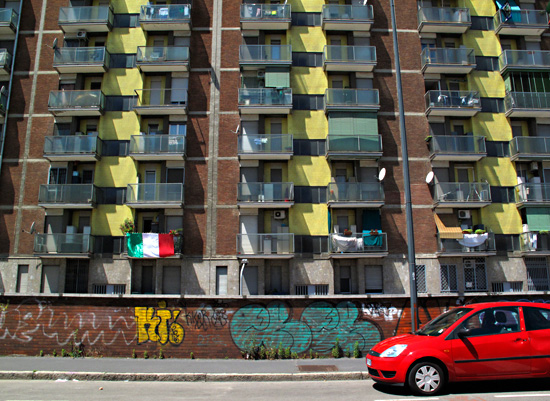
17 Giugno – June 17 – Milano
“A year ago today I got on a plane after having packed up half my life and given the other half away. My coming felt providential. I was compelled without knowing why. There have been times more difficult than I had anticipated, and other times that will always make my eyes sparkle. I truly believe this has been one of the best things I’ve done in and for my life. How wondrous!
And now, just a little over a month before my departure, I find myself as wide-eyed and seeing about Milano as I was about Seattle before I left. My senses are keen. I’m open to all of it with an intensity. I want to take it all in to carry back with me.
I feel a sadness about leaving. Now I know people. Now my heart is tied. I went out for pizza last night with Ewa, at the same restaurant where we met last July, a month after my arrival: Il Kaimon, (in the artsy Brera district. A street musician played classical music on a violin throughout dinner). Last year I was ecstatic to meet her and Piotr. They were my first spontaneous, independent friends here. Ewa and Piotr have remained friends all this time and their friendship has been a blessing. Ewa has fed me countless meals at their home. We’ve shared language, conversation and confidences. As my language grew, so did the depth of our talks. (She has invited me to stay with her when I return to Milano to visit.)
After our dinner, Ewa and I walked back to her apartment arm-in-arm, in Italian tradition, chatting all the way.”
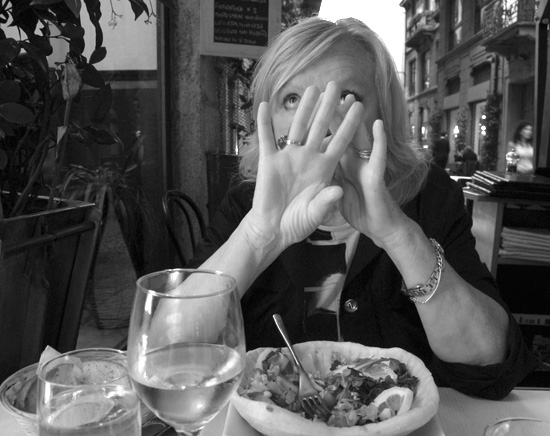
Ewa was shy about my having the camera out.
– – –
The Tricolore shows up in many ways. Yes, I really did see these two t-shirts hanging out to dry over the canal today as I was riding.
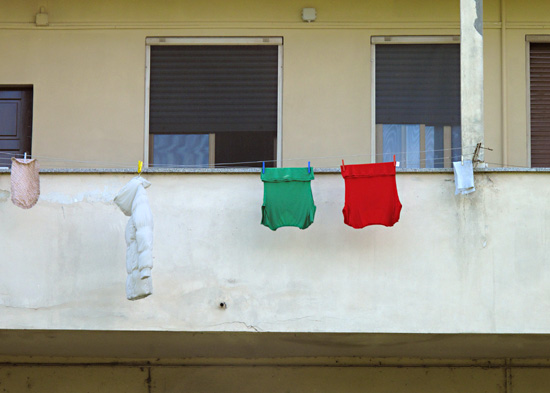
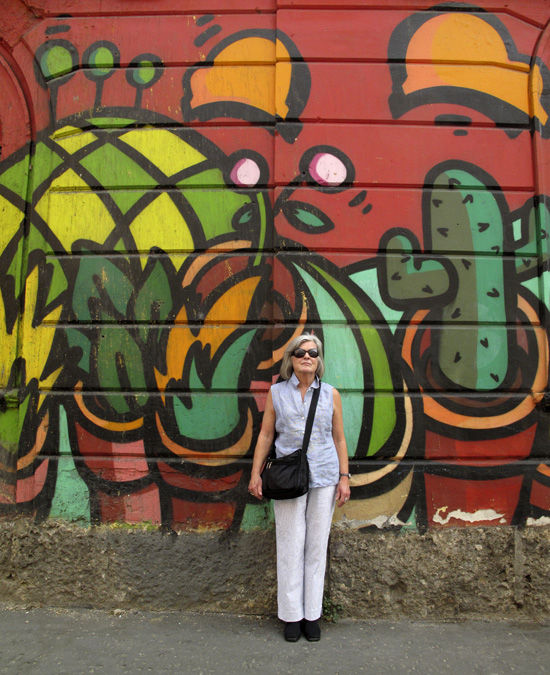
by Maureen | Jun 13, 2010 | Apartment, Church, Food!, Journal, Meals, People, Photos, Shopping & Markets
Sally flew over from Seattle a week ago to share the sights of Milano, the wonderful food treats available and the simple efficiency of my apartment. She came off the plane and out of customs beaming.
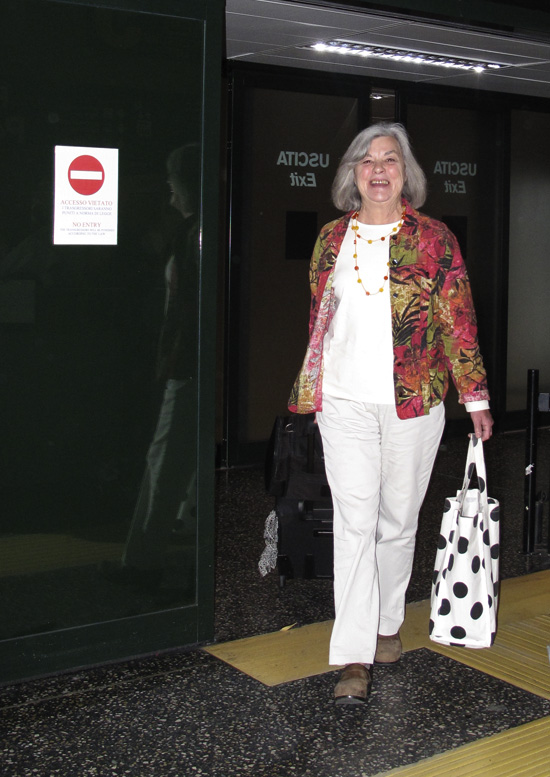
We took the Malpensa Express train from the airport into town, and got out at the Cadorna station. We walked out in front so she could see the “Needle, Thread and Knot” sculpture by Claes Oldenburg and Coosje van Bruggen. The knot is across the street, as if the needle had taken a stitch under the roadway.
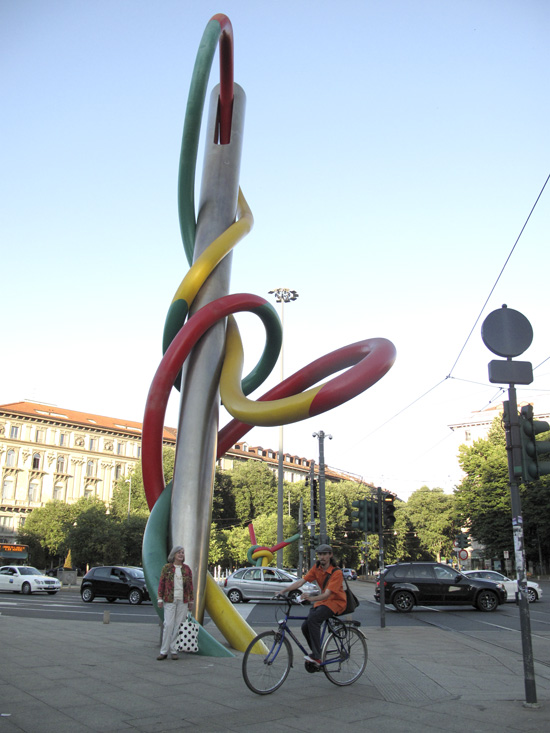
Our first breakfast was a caprese salad with mozzarella from the farm, lovely ripe tomatos, just-picked basil, served on a bed of songino – watercress – and some freshly sliced proscuitto. Not a bad welcome to Milano!
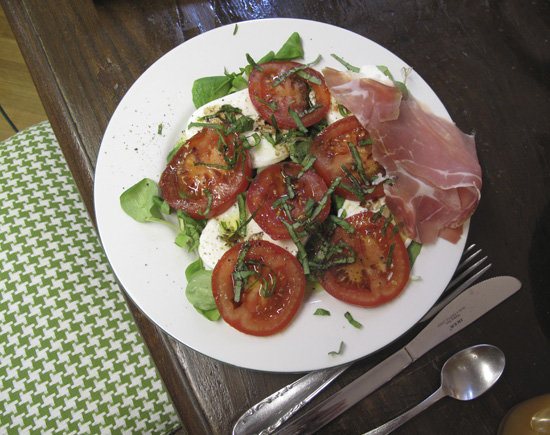
On Sally’s first day in Milano, we walked over to the Saturday street market where the vendors were selling fruit, vegetables, cheese, meat, fish, clothes and a few household goods. We stocked our kitchen with fresh basil, red pepper, asparagus, spicy salame with fennel, fresh eggs, cherry tomatoes, blood oranges, pickled onions, both “sweet” and spicy olives, burratina cheese, smoked mozzarella, dried figs from Calabria, prosciutto and bresaola.
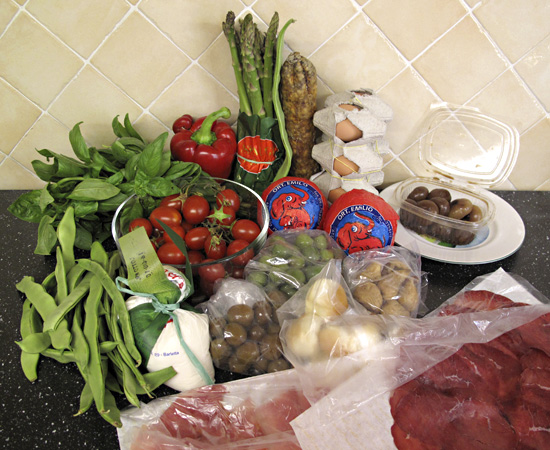
With hot weather, we opened the french doors and sat on my “shelf”, as Sally called it. Not quite big enough to be called a deck, or veranda, or lanai, it held our two chairs while we put our feet up on the railing. We chatted in the sun and greeted neighbors as they walked past to go dump their garbage in the room below us.
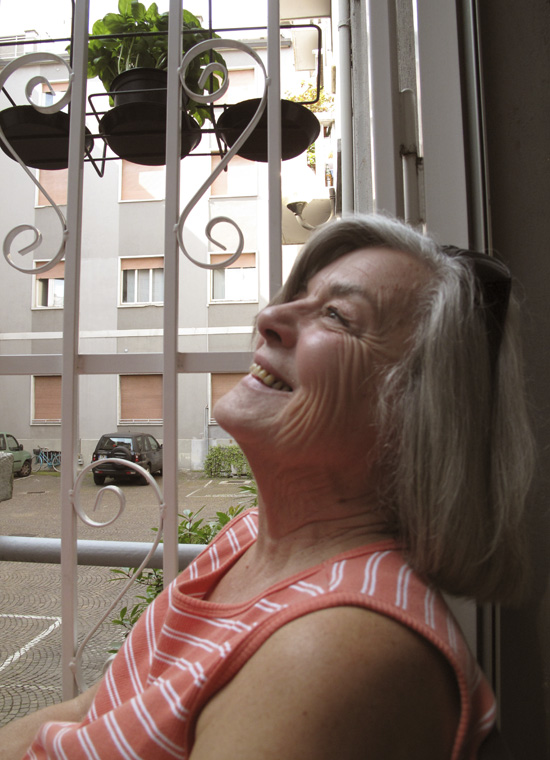
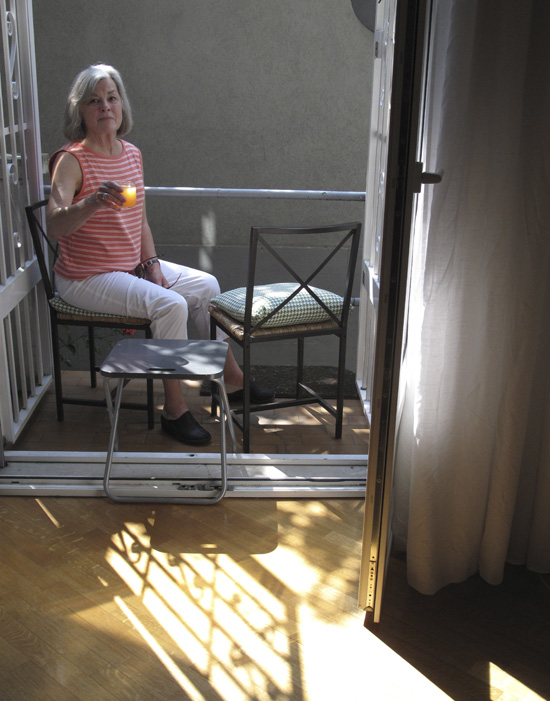
No trip to Milano would be complete without going out for aperitivi. We walked along the Naviglio Pavese Canal and stopped into one of the many restaurants that were hopping and lively on the hot, muggy night. We selected from their buffet of pasta, cheese, meats, pizza squares… and ribs (of all things). Sally’s martini was oddly sweet and not at all martini-like.
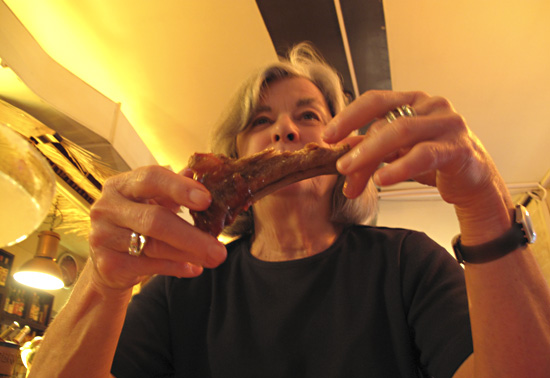
Sally enjoyed online communications, keeping in touch with family through Skype and e-mail.
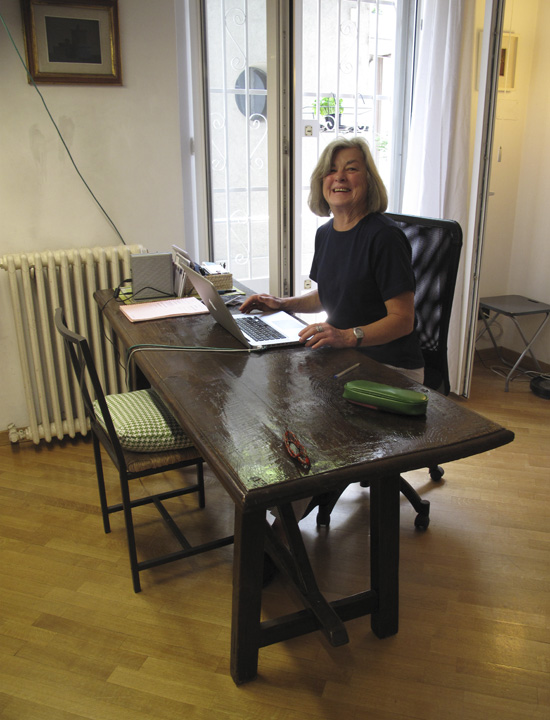
There’s a wonderful graffiti wall outside of a garden center between Corso Como and the Monumental Cemetery. What a great backdrop! This is one of my favorite photos of Sally in Milano.

We just had to take a stroll through 10 Corso Como, the city’s legendary fashion, accessories, art and design boutique. This is NOT the place to pull out your credit card, but rather just harvest ideas for garment design and construction.
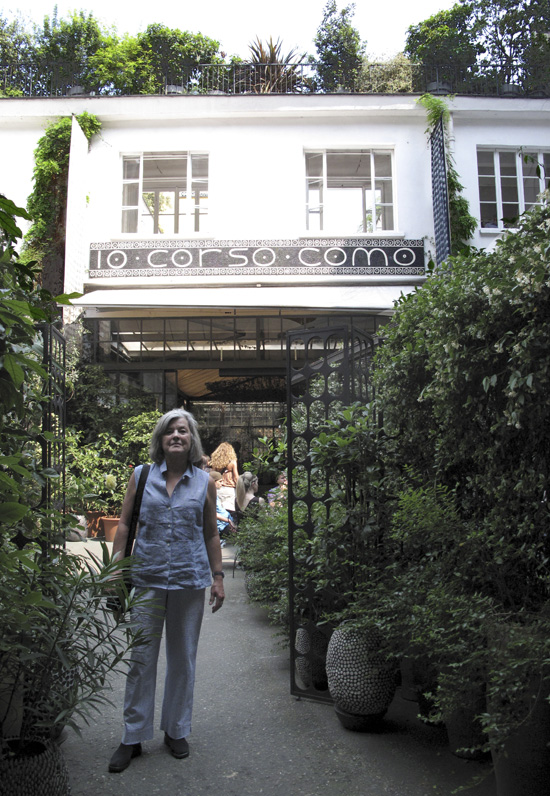
We made reservations for dinner on Saturday at Malavoglia where you ring the doorbell to get in and are greeted by bow-tie-adorned owner, Aldo, and a complementary glass of bubbly prosecco. We shared a primo of fresh pasta with black squid ink sauce. It was delicious.
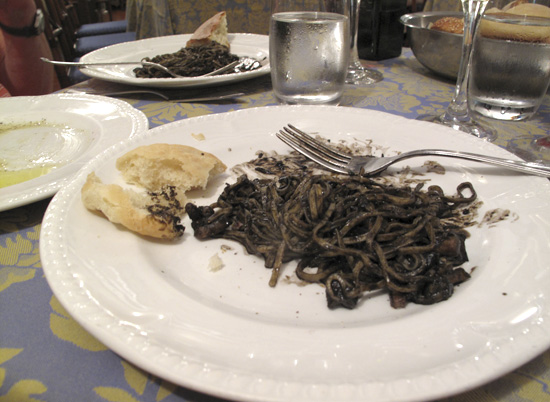
One of the highlights of Sally’s time in Milano was her visit to the Duomo. We spent time in the piazza, “the living room of the city”. We walked its circumference marveling at the variation in details and gloried at the cathedral’s interior. We topped off the tour with time on the rooftop, getting up close to the sculptures, finials and gargoyles, and looking out over the city.
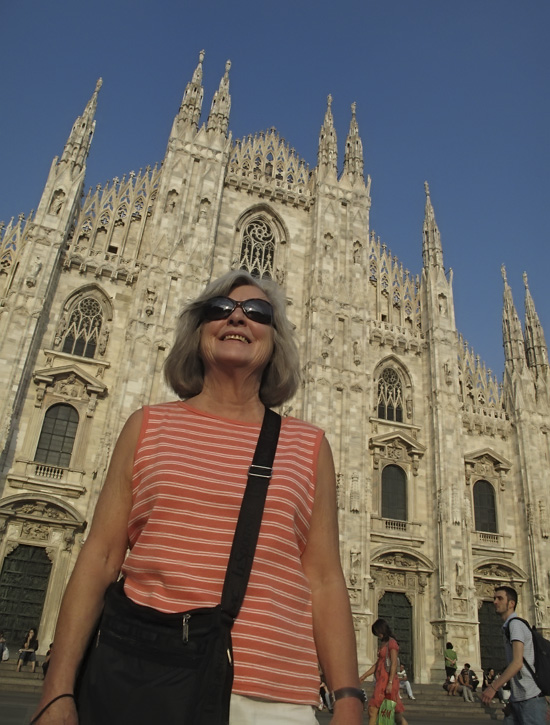
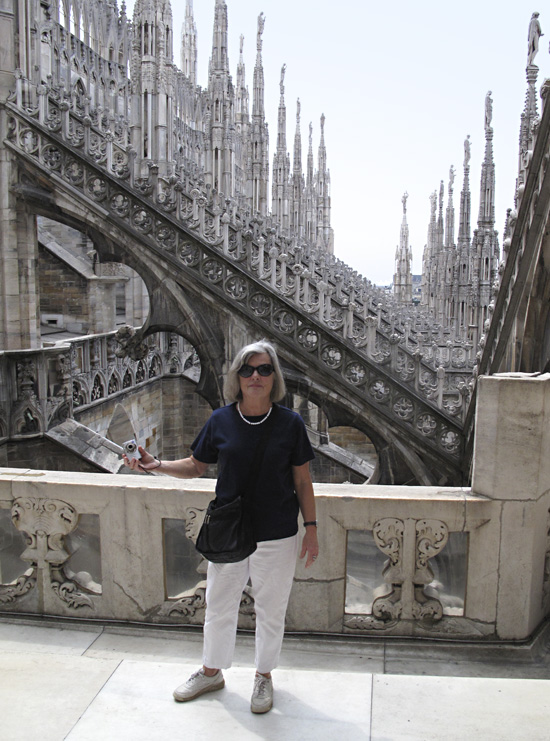



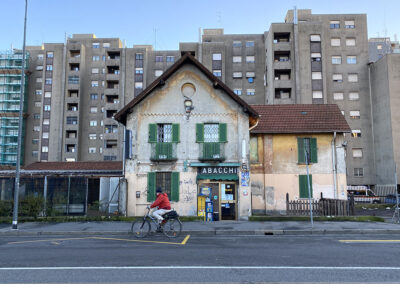
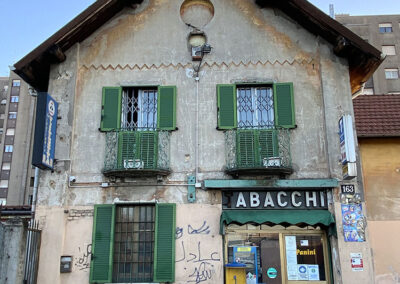
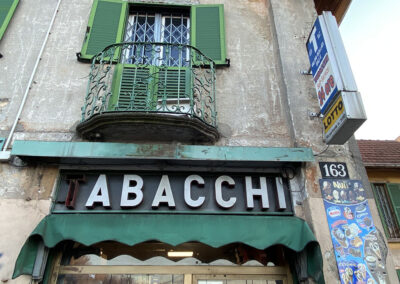
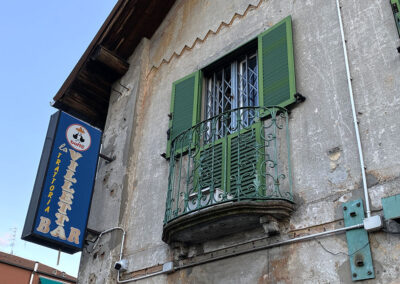
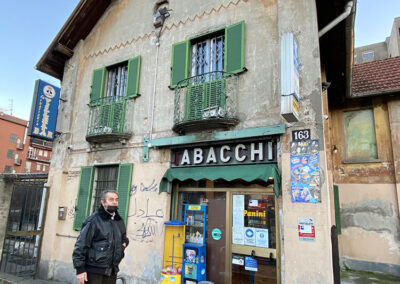
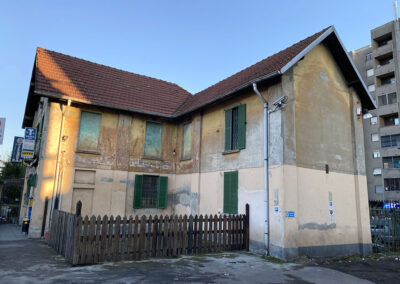

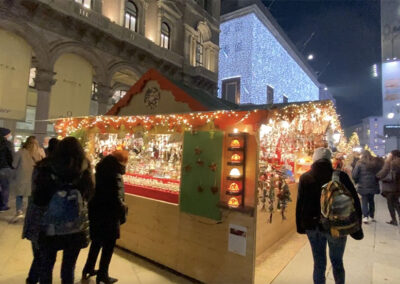
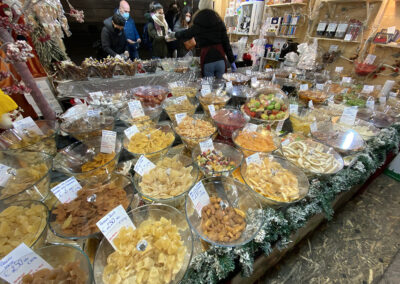
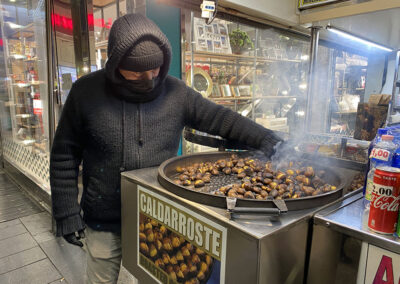
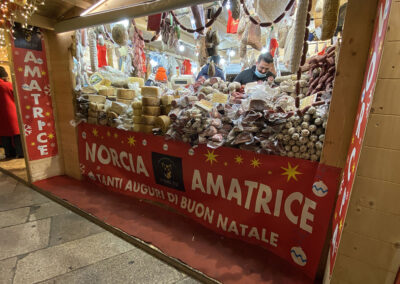
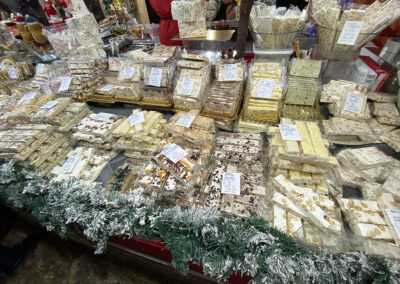
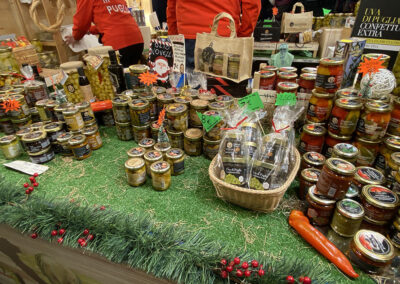

















 There is a long tunnel under the Tower, filled with historic photos of Seattle, Boeing and the local neighborhoods. After coming up from under the Rainier Tower, we started walking toward the waterfront along Union Street. One of the most ridiculous things I saw on our tour was a pair of pants displayed in the window at Brooks Brothers. They were embroidered with silly little doggies from top to bottom! Tell me, WHO would buy such pants? (Who would conceive of them and put them into production?!) Seeing these pants in the window stopped me in my tracks and had me laughing. Looks like this dog has his leash and is ready for a walk.
There is a long tunnel under the Tower, filled with historic photos of Seattle, Boeing and the local neighborhoods. After coming up from under the Rainier Tower, we started walking toward the waterfront along Union Street. One of the most ridiculous things I saw on our tour was a pair of pants displayed in the window at Brooks Brothers. They were embroidered with silly little doggies from top to bottom! Tell me, WHO would buy such pants? (Who would conceive of them and put them into production?!) Seeing these pants in the window stopped me in my tracks and had me laughing. Looks like this dog has his leash and is ready for a walk.





















































